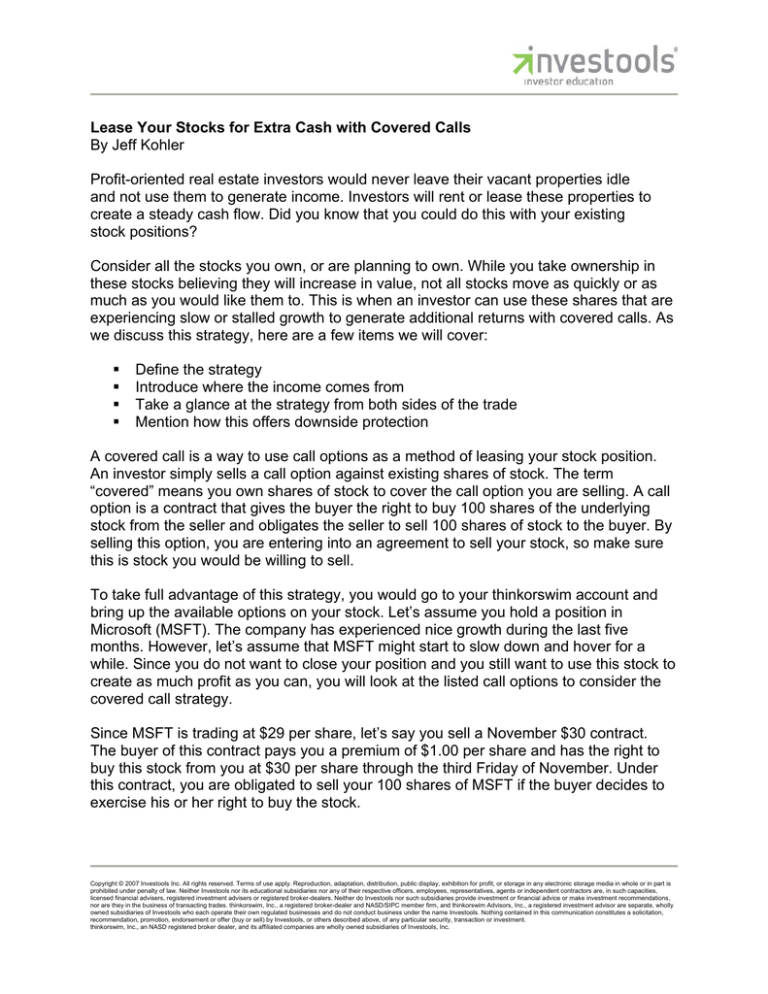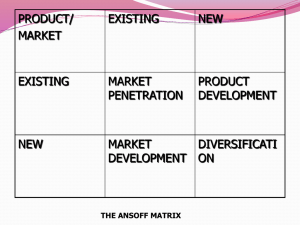
Lease Your Stocks for Extra Cash with Covered Calls
By Jeff Kohler
Profit-oriented real estate investors would never leave their vacant properties idle
and not use them to generate income. Investors will rent or lease these properties to
create a steady cash flow. Did you know that you could do this with your existing
stock positions?
Consider all the stocks you own, or are planning to own. While you take ownership in
these stocks believing they will increase in value, not all stocks move as quickly or as
much as you would like them to. This is when an investor can use these shares that are
experiencing slow or stalled growth to generate additional returns with covered calls. As
we discuss this strategy, here are a few items we will cover:
Define the strategy
Introduce where the income comes from
Take a glance at the strategy from both sides of the trade
Mention how this offers downside protection
A covered call is a way to use call options as a method of leasing your stock position.
An investor simply sells a call option against existing shares of stock. The term
“covered” means you own shares of stock to cover the call option you are selling. A call
option is a contract that gives the buyer the right to buy 100 shares of the underlying
stock from the seller and obligates the seller to sell 100 shares of stock to the buyer. By
selling this option, you are entering into an agreement to sell your stock, so make sure
this is stock you would be willing to sell.
To take full advantage of this strategy, you would go to your thinkorswim account and
bring up the available options on your stock. Let’s assume you hold a position in
Microsoft (MSFT). The company has experienced nice growth during the last five
months. However, let’s assume that MSFT might start to slow down and hover for a
while. Since you do not want to close your position and you still want to use this stock to
create as much profit as you can, you will look at the listed call options to consider the
covered call strategy.
Since MSFT is trading at $29 per share, let’s say you sell a November $30 contract.
The buyer of this contract pays you a premium of $1.00 per share and has the right to
buy this stock from you at $30 per share through the third Friday of November. Under
this contract, you are obligated to sell your 100 shares of MSFT if the buyer decides to
exercise his or her right to buy the stock.
Copyright © 2007 Investools Inc. All rights reserved. Terms of use apply. Reproduction, adaptation, distribution, public display, exhibition for profit, or storage in any electronic storage media in whole or in part is
prohibited under penalty of law. Neither Investools nor its educational subsidiaries nor any of their respective officers, employees, representatives, agents or independent contractors are, in such capacities,
licensed financial advisers, registered investment advisers or registered broker-dealers. Neither do Investools nor such subsidiaries provide investment or financial advice or make investment recommendations,
nor are they in the business of transacting trades. thinkorswim, Inc., a registered broker-dealer and NASD/SIPC member firm, and thinkorswim Advisors, Inc., a registered investment advisor are separate, wholly
owned subsidiaries of Investools who each operate their own regulated businesses and do not conduct business under the name Investools. Nothing contained in this communication constitutes a solicitation,
recommendation, promotion, endorsement or offer (buy or sell) by Investools, or others described above, of any particular security, transaction or investment.
thinkorswim, Inc., an NASD registered broker dealer, and its affiliated companies are wholly owned subsidiaries of Investools, Inc.
Imagine that MSFT is trading at $32 at expiration. The buyer of your option has the right
to purchase the stock from you at $30. With the current market price at $32, if the buyer
bought your shares at $30 and sold them back to the market at $32, the buyer would
yield a $2 profit on the stock. Once the $1 premium is subtracted from the gain, the
buyer makes a $1 profit on this trade ($32 - $30 = $2) ($2 - $1 = $1).
Let’s look at this trade from your perspective. If you purchased the stock at $29 per
share, and then you fulfilled your call obligation to sell the stock and sold it for $30, you
would have made a $1 profit. But wait, the option buyer also paid you a $1 premium to
buy the call. Therefore, you make a total return of $2.
What if MSFT remains at its current price at expiration? If the price per share at
expiration is $29, the buyer of this contract would have no incentive to exercise the
option and buy the stock from you. There is no reason to pay $30 for a stock when it is
trading at $29 per share. The option would expire worthless and the premium you
collected is yours to keep. So if you had paid $29 for the shares of MSFT and the price
has not moved, you would still have made $1 on this trade.
Another added benefit to this strategy is your downside protection. The premium you
receive in this trade brings your cost basis for the trade down, meaning you can weather
some price movement to the downside without losing ground in the trade. Going back to
the example, if your original cost basis is $29, and you are paid a $1 premium, your new
cost basis, or breakeven point, drops to $28 ($29 - $1 = $8). If MSFT pulls back to $28,
your $1 premium offsets this loss in the stock price, and you are still breaking even on
the trade.
Selling covered calls can help you generate consistent streams of income while
simultaneously offering you downside protection. Here are a few key points to
remember:
Aim for selling calls month to month when appropriate. This will bring cash into
your thinkorswim account every month.
Make sure you don’t limit your upside. If you expect the stock to move
increasingly higher, a covered call will allow you to profit only up to the strike
price you are selling. Covered calls aren’t appropriate for all stocks.
Don’t use this strategy on stocks you aren’t willing to sell, because you might be
required to sell.
Don’t use this strategy to rationalize holding on to a bad stock. If you see the
stock moving below your breakeven point, research the condition of the company
to insure it is worth owning.
Copyright © 2007 Investools Inc. All rights reserved. Terms of use apply. Reproduction, adaptation, distribution, public display, exhibition for profit, or storage in any electronic storage media in whole or in part is
prohibited under penalty of law. Neither Investools nor its educational subsidiaries nor any of their respective officers, employees, representatives, agents or independent contractors are, in such capacities,
licensed financial advisers, registered investment advisers or registered broker-dealers. Neither do Investools nor such subsidiaries provide investment or financial advice or make investment recommendations,
nor are they in the business of transacting trades. thinkorswim, Inc., a registered broker-dealer and NASD/SIPC member firm, and thinkorswim Advisors, Inc., a registered investment advisor are separate, wholly
owned subsidiaries of Investools who each operate their own regulated businesses and do not conduct business under the name Investools. Nothing contained in this communication constitutes a solicitation,
recommendation, promotion, endorsement or offer (buy or sell) by Investools, or others described above, of any particular security, transaction or investment.
thinkorswim, Inc., an NASD registered broker dealer, and its affiliated companies are wholly owned subsidiaries of Investools, Inc.
The covered call strategy is a conservative, income-producing strategy. Start analyzing
your current stock trades and see how covered calls would supplement your investment
approach today.
Copyright © 2007 Investools Inc. All rights reserved. Terms of use apply. Reproduction, adaptation, distribution, public display, exhibition for profit, or storage in any electronic storage media in whole or in part is
prohibited under penalty of law. Neither Investools nor its educational subsidiaries nor any of their respective officers, employees, representatives, agents or independent contractors are, in such capacities,
licensed financial advisers, registered investment advisers or registered broker-dealers. Neither do Investools nor such subsidiaries provide investment or financial advice or make investment recommendations,
nor are they in the business of transacting trades. thinkorswim, Inc., a registered broker-dealer and NASD/SIPC member firm, and thinkorswim Advisors, Inc., a registered investment advisor are separate, wholly
owned subsidiaries of Investools who each operate their own regulated businesses and do not conduct business under the name Investools. Nothing contained in this communication constitutes a solicitation,
recommendation, promotion, endorsement or offer (buy or sell) by Investools, or others described above, of any particular security, transaction or investment.
thinkorswim, Inc., an NASD registered broker dealer, and its affiliated companies are wholly owned subsidiaries of Investools, Inc.







